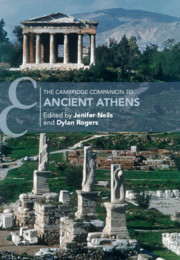Book contents
- The Cambridge Companion to Ancient Athens
- Cambridge Companions to the Ancient World
- The Cambridge Companion to Ancient Athens
- Copyright page
- Contents
- Contributors
- Abbreviations
- Athens: An Introduction
- 1 #Leagros: An Athenian Life
- Part I The Urban Fabric
- 2 Asty and Chora: City and Countryside
- 3 The Emergence of the Polis
- 4 City Streets, Walls, and Gates
- 5 The Akropolis
- 6 The Agora: Public Life and Administration
- 7 Athenian Inscriptions
- 8 Water and Water Management
- 9 Housing and the Household
- 10 The Archaic and Classical Cemeteries
- Part II Inhabitants
- Part III Business/Commerce
- Part IV Culture and Sport
- Part V Politics
- Reception
- Index
- References
7 - Athenian Inscriptions
from Part I - The Urban Fabric
Published online by Cambridge University Press: 10 March 2021
- The Cambridge Companion to Ancient Athens
- Cambridge Companions to the Ancient World
- The Cambridge Companion to Ancient Athens
- Copyright page
- Contents
- Contributors
- Abbreviations
- Athens: An Introduction
- 1 #Leagros: An Athenian Life
- Part I The Urban Fabric
- 2 Asty and Chora: City and Countryside
- 3 The Emergence of the Polis
- 4 City Streets, Walls, and Gates
- 5 The Akropolis
- 6 The Agora: Public Life and Administration
- 7 Athenian Inscriptions
- 8 Water and Water Management
- 9 Housing and the Household
- 10 The Archaic and Classical Cemeteries
- Part II Inhabitants
- Part III Business/Commerce
- Part IV Culture and Sport
- Part V Politics
- Reception
- Index
- References
Summary
This chapter surveys the major Athenian inscriptional genres as well as their placement and distribution over time, and attempts to convey what it might have meant to a passerby to experience the ‘inscribed’ city.
- Type
- Chapter
- Information
- The Cambridge Companion to Ancient Athens , pp. 98 - 109Publisher: Cambridge University PressPrint publication year: 2021
References
Further Reading
The study of Athenian, and Attic, epigraphy is old. The great collection of (most) Greek inscriptions is Inscriptiones Graecae, where volume I3 covers Attic inscriptions down to the year 403/2 bc, and IG II/III2 the years thereafter. This latter set is being republished: IG II/III3 1.2, 1.4, and 1.5 (laws and decrees 352/–322/1, 300/299–230/29, and 229/8–168/7 BC), IG II/III3 4.1 (public and choregic dedications), and IG II/III3 5 (Late Antiquity). IG publishes in Greek with commentary in Latin, and with no translations in the printed versions; I have therefore chosen as specific examples here mostly inscriptions that can be found in Rhodes and Osborne 2003 (RO) and Osborne and Rhodes 2017 (OR), which constitute rich collections, with English translations and commentaries, of specific inscriptions, many of them Athenian. For ease of accessibility, excellent translations and brief commentaries, and a rapidly growing body of inscriptions (added to quarterly), see Lambert’s www.atticinscriptionsonline.com. The other major source of Athenian inscriptions is the Agora series, of which Agora 18 (Inscriptions: The Dedicatory Monuments [2011]), Agora 19 (Inscriptions: Horoi, Poletai Records, Leases of Public Lands [1991]), Agora 21 (Graffiti and Dipinti [1976]), and Agora 25 (Ostraka [1990]) are cited here. This essay is also much indebted to Lambert forthcoming, an excellent overview of Athenian epigraphy with greater attention to some other sub-genres of Athenian inscriptions (mortgage-horoi, cavalry tickets, etc.) and to some technical details (history of epigraphy, dating, letter forms, onomastics and prosopography, the science of epigraphy) than there was room for here.
For Athenian epitaphs, there is no good overview, but for an argument addressing the great increase of Athenian epitaphs in the fourth century, see Meyer 1993. For inscribed Akropolis dedications from the Archaic period, Keesling 2003; for Akropolis ‘inventories’ (paradoseis, kathareseis, exetasmoi), Harris 1995. For inscriptions as honors to the gods, Meyer 2013, which also investigates earlier theories of democratic functionality, as well as significant placement on both Akropolis and in the Agora; for the latter, see also Shear 2011, and (especially) Lambert 2018, who lays out the bigger (more long-term) picture and cites the (few) factors that ‘drive’ the erection of inscriptions away from the Akropolis. For format as conveyer of knowledge, Meyer 2017. For honorific inscriptions as a significant element of Athenian foreign policy, Liddel 2010. On the relationship of literacy and democracy, Missiou 2011 is optimistic; of Athenian Empire to Akropolis inscribing, Moroo 2016.



